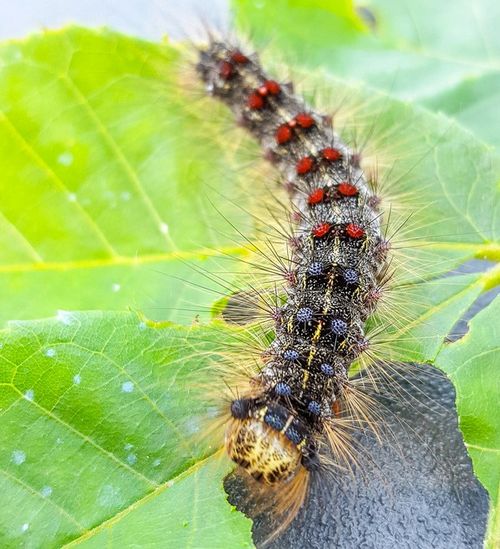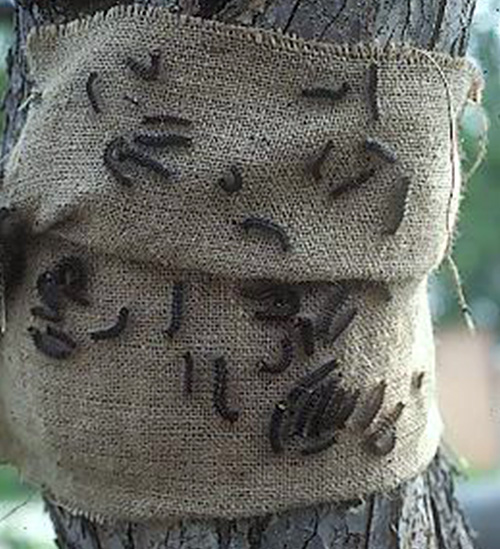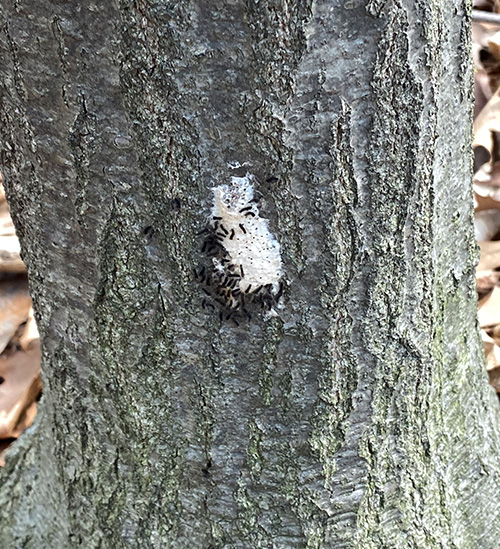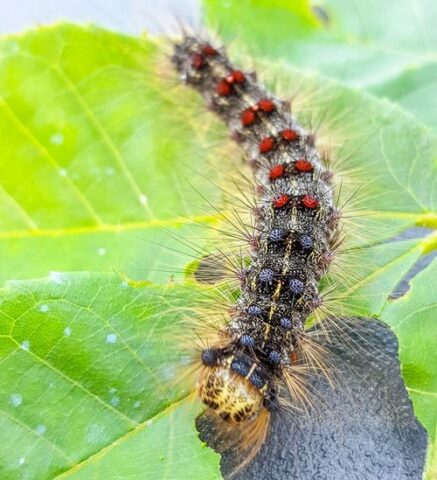Are creeping caterpillars spoiling your early summer fun or harming your trees? Spongy Moth caterpillars are making messes and gobbling tree leaves in many yards, parks and natural areas around St. Clair County.



Left: Spongy Moth caterpillar feeding on leaves (Michigan State University)
Center: Burlap hiding band attracts caterpillars (University of Wisconsin Madison)
Right: Egg mass with newly hatched caterpillars (Kirsten Lyons)
This exotic invasive forest pest was introduced into the U.S. over 150 years ago and has been posing ecological threats ever since. The caterpillars hatch in late spring from egg masses laid the previous fall. The tiny, hairy, hungry caterpillars begin dispersing and feeding as the tree leaves unfurl, and they spend the next few weeks growing into two to three inch long leaf eaters. Their favorite food is oak leaves, although they will feed on many tree and shrub species.
Leaf removal, also known as defoliation, comes at a bad time for the trees–when they’ve recently spent their energy to flower and leaf out. Most trees and shrubs will have enough health and vigor to put out a fresh set of replacement leaves so that they can photosynthesize and feed themselves once again. Developing this second set of leaves, however, can use reserves that might have been better spent getting through a hot summer, fighting off other pests and stress, expanding root systems, or storing away energy for the winter. Trees and shrubs that are significantly defoliated can be set back or even killed if this happens early in the season for more than a couple of years in a row. It’s also a very stressful time for people. The leaf fragments and frass (caterpillar dung) raining down from the trees, loss of shade, and sheer numbers of large hairy caterpillars are enough to drive homeowners and trail users to flee or take cover indoors.
What can you do?
First, don’t panic. Like any other pest, Spongy Moth populations are cyclical. While they may be numerous, annoying and destructive at times, eventually they will dwindle. The only stage of the life cycle that’s harmful to trees is the caterpillar phase, so most of the damage and aggravation will stop in July as the caterpillars move into their pupal phase before metamorphosing into adult moths and laying egg masses.
Second, take action. Keep your trees and shrubs as healthy as possible and do what you can to reduce caterpillar numbers around your home and outdoor spaces. Water valuable shade trees during hot, dry weather and avoid damaging roots. Consider using hiding bands to protect individual trees or your favorite gathering places. You can check out our hiding band demonstration video here. Flick the caterpillars you find in the bands into a can of soapy water each day to reduce the number of larvae and the amount of frass raining down on your patio. Never handle caterpillars with your bare hands as their urticating hairs may give you a stinging, burning rash.
Third, communicate. If you have caterpillar issues it’s likely your neighbors do, too. Share the location of your infestation on the St. Clair County Spongy Moth Program website at www.stclaircounty.org/caterpillars.
Next steps
By late summer, Spongy Moth populations will have laid egg masses that will overwinter to start the cycle all over next spring. St. Clair County contracted with Friends of the St. Clair River to administer the 2022 Spongy Moth Suppression Program. Reach out to us at spongymoth@scriver.org with questions and for more information.
Do you have nature stories or observations you’d like to share? Leave us a comment!
(This original article was written and published on June 3, 2021 by Kirsten Lyons, Friends of the St. Clair River Spongy Moth Program Coordinator. Revisions to the article were made on June 12, 2022 by Sheri Faust to reflect the Spongy Moth name change (formerly Gypsy Moth) and 2022 program updates. Thanks to Kirsten for providing the content for this article.)


11 Comments
[…] Our earlier blog post, Gypsy Moth – An unwelcome start to summer […]
The defoliation is really bad in central Arcadia Township, Lapeer County. White oak is the worst hit, but even eastern white pine is being consumed. Let us hope that the winter of 2021-2022 is particularly severe (temperatures of minus 29 Celsius and less are said to kill gypsy moth eggs).
Hi John, Thanks for telling us about Arcadia. It’s good to know we’re not alone! That is a great point about mild winter temperatures being a contributing factor. Yes, let’s hope for better conditions this coming winter.
We are losing our beautiful trees. Help Michiganders keep our wooded area’s by spraying for the larvae next early Spring or we will live in a open field state.
Hi Janet, our healthy, deciduous trees will largely survive a couple of years or more of defoliation. Give them a chance, and if possible, some extra water, and they will probably leaf out again this season. Your pine trees you mentioned in your previous comment may be more severely impacted.
We are having a horrible time with these disgusting things. Manny of our oak trees are already bare. The gypsy moths are also infesting the evergreen trees as well. The needles are all over the ground and the caterpillars are thick in the branches of the pine trees as well as oaks. If the counties affected in Michigan don’t spray for these larvae in the Spring, the beautiful wooded areas in Michigan are going to become open fields. Talk about Green Energy protecting the climate, trees are the best air purifier as well as protection from the hot sun in summer and cold winds of winter. I think the residents of Michigan are “Entitled “ to clean air and beautiful trees. Take a poll and see how many Michiganders are willing to have money added to taxes to save our trees.
Hi Janet, I’m sorry to hear you and your trees are suffering. Have you already reported your issues to municipal and county officials? Community leaders need to know where infestations are to develop an action plan. If you’re comfortable reporting on the Midwest Invasive Species Information Network (MISIN) app (www.misin.msu.edu), I’d suggest doing that, too, so that state and regional natural resources agencies and researchers can be informed and can better support us as we move through this together.
We have been using our shop vac with a little bit of soapy water in the bottom. We vacuum the outside of our house and EVERYTHING in our yard. Don’t know if we are making a dent but at least we are fighting back. They are the worst I have ever seen them!
Hi Susan,
Thanks for sharing your ideas! I’m sorry to hear you’re experiencing these challenges. It sounds like you’ve discovered a good way to keep the caterpillar numbers down. I might try that myself!
back in the 90’s the county air sprayed them. do you have plans on doing it this year?
Hi Sally,
Thanks for asking! The window for aerial sprays has passed for this year. We are encouraging anyone experiencing Gypsy Moth issues to report their observations and upload their photos to the Midwest Invasive Species Information Network (MISIN) at https://www.misin.msu.edu/ or on the free smartphone app by the same name. This data will help assess the problem and support future management efforts.